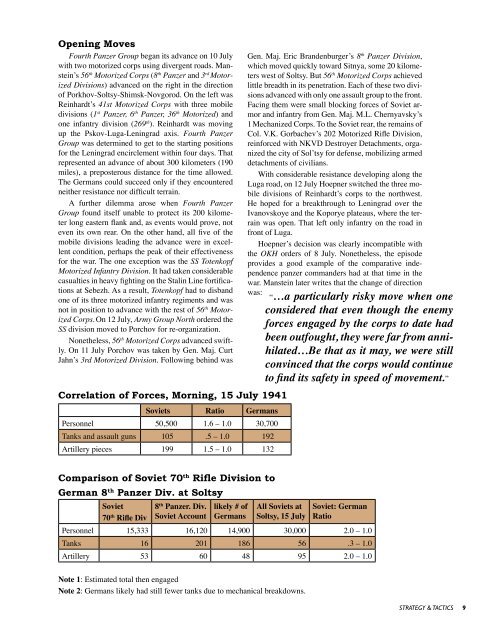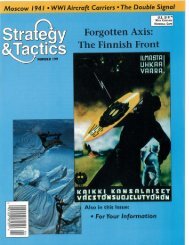COUNTERSTROKE AT SOLTSY - Strategy & Tactics Press
COUNTERSTROKE AT SOLTSY - Strategy & Tactics Press
COUNTERSTROKE AT SOLTSY - Strategy & Tactics Press
Create successful ePaper yourself
Turn your PDF publications into a flip-book with our unique Google optimized e-Paper software.
Opening Moves<br />
Fourth Panzer Group began its advance on 10 July<br />
with two motorized corps using divergent roads. Manstein’s<br />
56 th Motorized Corps (8 th Panzer and 3 rd Motorized<br />
Divisions) advanced on the right in the direction<br />
of Porkhov-Soltsy-Shimsk-Novgorod. On the left was<br />
Reinhardt’s 41st Motorized Corps with three mobile<br />
divisions (1 st Panzer, 6 th Panzer, 36 th Motorized) and<br />
one infantry division (269 th ). Reinhardt was moving<br />
up the Pskov-Luga-Leningrad axis. Fourth Panzer<br />
Group was determined to get to the starting positions<br />
for the Leningrad encirclement within four days. That<br />
represented an advance of about 300 kilometers (190<br />
miles), a preposterous distance for the time allowed.<br />
The Germans could succeed only if they encountered<br />
neither resistance nor difficult terrain.<br />
A further dilemma arose when Fourth Panzer<br />
Group found itself unable to protect its 200 kilometer<br />
long eastern flank and, as events would prove, not<br />
even its own rear. On the other hand, all five of the<br />
mobile divisions leading the advance were in excellent<br />
condition, perhaps the peak of their effectiveness<br />
for the war. The one exception was the SS Totenkopf<br />
Motorized Infantry Division. It had taken considerable<br />
casualties in heavy fighting on the Stalin Line fortifications<br />
at Sebezh. As a result, Totenkopf had to disband<br />
one of its three motorized infantry regiments and was<br />
not in position to advance with the rest of 56 th Motorized<br />
Corps. On 12 July, Army Group North ordered the<br />
SS division moved to Porchov for re-organization.<br />
Nonetheless, 56 th Motorized Corps advanced swiftly.<br />
On 11 July Porchov was taken by Gen. Maj. Curt<br />
Jahn’s 3rd Motorized Division. Following behind was<br />
Correlation of Forces, Morning, 15 July 1941<br />
Soviets Ratio Germans<br />
Personnel 50,500 1.6 – 1.0 30,700<br />
Tanks and assault guns 105 .5 – 1.0 192<br />
Artillery pieces 199 1.5 – 1.0 132<br />
Comparison of Soviet 70 th Rifle Division to<br />
German 8 th Panzer Div. at Soltsy<br />
Soviet<br />
70 th Rifle Div<br />
8 th Panzer. Div.<br />
Soviet Account<br />
likely # of<br />
Germans<br />
All Soviets at<br />
Soltsy, 15 July<br />
Soviet: German<br />
Ratio<br />
Personnel 15,333 16,120 14,900 30,000 2.0 – 1.0<br />
Tanks 16 201 186 56 .3 – 1.0<br />
Artillery 53 60 48 95 2.0 – 1.0<br />
Note 1: Estimated total then engaged<br />
Note 2: Germans likely had still fewer tanks due to mechanical breakdowns.<br />
Gen. Maj. Eric Brandenburger’s 8 th Panzer Division,<br />
which moved quickly toward Sitnya, some 20 kilometers<br />
west of Soltsy. But 56 th Motorized Corps achieved<br />
little breadth in its penetration. Each of these two divisions<br />
advanced with only one assault group to the front.<br />
Facing them were small blocking forces of Soviet armor<br />
and infantry from Gen. Maj. M.L. Chernyavsky’s<br />
1 Mechanized Corps. To the Soviet rear, the remains of<br />
Col. V.K. Gorbachev’s 202 Motorized Rifle Division,<br />
reinforced with NKVD Destroyer Detachments, organized<br />
the city of Sol’tsy for defense, mobilizing armed<br />
detachments of civilians.<br />
With considerable resistance developing along the<br />
Luga road, on 12 July Hoepner switched the three mobile<br />
divisions of Reinhardt’s corps to the northwest.<br />
He hoped for a breakthrough to Leningrad over the<br />
Ivanovskoye and the Koporye plateaus, where the terrain<br />
was open. That left only infantry on the road in<br />
front of Luga.<br />
Hoepner’s decision was clearly incompatible with<br />
the OKH orders of 8 July. Nonetheless, the episode<br />
provides a good example of the comparative independence<br />
panzer commanders had at that time in the<br />
war. Manstein later writes that the change of direction<br />
was: “…a particularly risky move when one<br />
considered that even though the enemy<br />
forces engaged by the corps to date had<br />
been outfought, they were far from annihilated…Be<br />
that as it may, we were still<br />
convinced that the corps would continue<br />
to find its safety in speed of movement.”<br />
strategy & tactics 9







